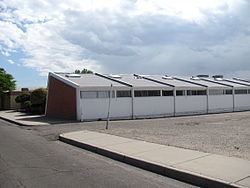Built 1956 NMSRCP # 1171 Opened 1956 Added to NRHP 10 October 1989 | NRHP Reference # 89001589 Designated NMSRCP May 17, 1985 Architectural style International Style | |
 | ||
Similar Albuquerque Aquarium, ABQ BioPark Botanic G, Albuquerque Biological Park, American International Rattlesna, Cliff's Amusement Park | ||
The Solar Building, located in Albuquerque, New Mexico, was the world's first commercial building to be heated primarily by solar energy. It was built in 1956 to house the engineering firm of Frank Bridgers and Donald Paxton, who were responsible for the heating system design. The novel building received writeups in Life and Popular Mechanics and was the subject of an NSF-funded research project in the 1970s. It was added to the New Mexico State Register of Cultural Properties in 1985 and the National Register of Historic Places in 1989.
Contents
History
Bridgers and Paxton came up with the idea for an experimental solar-heated building in the early 1950s. After two years of design work, the Solar Building was constructed between March and August 1956 for a cost of $58,500. The heating system operated successfully for six years but was nevertheless converted to a conventional boiler system when the building was expanded in 1962. However, the 1973 oil crisis caused a renewed interest in solar energy and brought fresh attention to the Solar Building. In early 1974, Penn State researcher Stanley Gilman received an NSF grant to restore the building's solar heating system and operate it as part of a multi-year field study. The system was deactivated following the conclusion of the project but remains mostly intact.
Heating system
The building's active solar heating system employed an 800-square-foot (74 m2) collector array on the south wall of the building, which was angled at 30 degrees to the vertical to catch the maximum amount of winter sunlight. Hot water from the collectors fed a 6,000-gallon insulated tank, which provided a reserve for nights and cloudy periods. Under normal conditions the water in the tank would be sufficiently warm to directly heat the building, but if the temperature in the tank dropped (e.g. due to prolonged cloudy weather), a heat pump could be employed to extract the remaining useful heat from the water stream.
Gilman made several modifications to the system in the 1970s, including automating the control system, changing the working fluid in the collector loop to ethylene glycol, and retrofitting the collector panels for better thermal contact.
